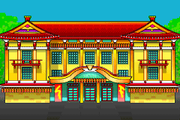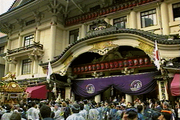Kabuki Theater: Difference between revisions
From the Super Mario Wiki, the Mario encyclopedia
Jump to navigationJump to search
mNo edit summary |
Derekblue1 (talk | contribs) |
||
| (4 intermediate revisions by the same user not shown) | |||
| Line 1: | Line 1: | ||
{{quote|Kabuki is a highly stylized and formal type of Japanese theater. It was started as a dance form in 1603 by a female temple servant. The present form of theater prohibits women from participating and as a result, men take all the parts, portraying women by the use of masks and makeup. The plays are performed to the accompaniment of traditional music, especially that of the samisen. The Kabuki plays are presented on revolving stages, with scene and costume changes taking place in front of the viewers.|'''Pamphlet'''|Mario is Missing! (PC)}} | {{quote|Kabuki is a highly stylized and formal type of Japanese theater. It was started as a dance form in 1603 by a female temple servant. The present form of theater prohibits women from participating and as a result, men take all the parts, portraying women by the use of masks and makeup. The plays are performed to the accompaniment of traditional music, especially that of the samisen. The Kabuki plays are presented on revolving stages, with scene and costume changes taking place in front of the viewers.|'''Pamphlet'''|Mario is Missing! (PC)}} | ||
{{multiple image | |||
A particular '''{{wp|Kabuki}} Theater''' in [[Tokyo]], [[Japan]] appears as a landmark in the PC version of ''[[Mario is Missing! (PC)|Mario is Missing!]]''. In the game, a [[Koopa Troopa]] steals a [[mask from the Kabuki Theater]], forcing its information booth to close until [[Luigi]] returns it. | |align=right | ||
|direction=vertical | |||
|width=180 | |||
|footer=Kabuki Theater in DOS and ''CD-ROM Deluxe'' versions. | |||
|image1=MiM Kabuki Theatre.png | |||
|alt1=DOS | |||
|image2=Kabuki Theater MIMCD.png | |||
|alt2=''CD-ROM Deluxe'' | |||
}} | |||
A particular '''{{wp|Kabuki}} Theater''' in [[Tokyo]], [[Japan]] appears as a landmark in the PC version of ''[[Mario is Missing! (PC)|Mario is Missing!]]''. In the game, a [[Koopa Troopa]] steals a [[mask from the Kabuki Theater]], forcing its information booth to close until [[Luigi]] returns it. | |||
== Questions == | |||
To prove the mask's authenticity, he must first correctly answer two of the following questions: | |||
*''What is the Kabuki mask made of?'' | *''What is the Kabuki mask made of?'' | ||
**tin | **tin | ||
| Line 12: | Line 23: | ||
**men | **men | ||
**viewers | **viewers | ||
*''The form of theater was orignally a style of:'' | |||
** sandwich | |||
** opera | |||
** '''dance''' | |||
** musical instrument | |||
==Names in other languages== | |||
{{foreign names | |||
|Fre=Le Théâtre du Kabuki | |||
|FreC=<ref>{{cite|publisher=[[Software Toolworks]]|title=''Mario a disparu''|language=French|accessdate=April 22, 2025}}</ref> | |||
|Ger=Das Kabuki-Theater | |||
|GerC=<ref>{{cite|publisher=[[Software Toolworks]]|title=''Mario wir vermisst''|language=German|accessdate=March 11, 2025}}</ref> | |||
}} | |||
==References== | |||
<references/> | |||
{{MIM}} | {{MIM}} | ||
[[Category:Buildings]] | [[Category:Buildings]] | ||
[[Category:Mario is Missing! landmarks]] | [[Category:Mario is Missing! landmarks]] | ||
Latest revision as of 10:51, April 22, 2025
- “Kabuki is a highly stylized and formal type of Japanese theater. It was started as a dance form in 1603 by a female temple servant. The present form of theater prohibits women from participating and as a result, men take all the parts, portraying women by the use of masks and makeup. The plays are performed to the accompaniment of traditional music, especially that of the samisen. The Kabuki plays are presented on revolving stages, with scene and costume changes taking place in front of the viewers.”
- —Pamphlet, Mario is Missing! (PC)
A particular Kabuki Theater in Tokyo, Japan appears as a landmark in the PC version of Mario is Missing!. In the game, a Koopa Troopa steals a mask from the Kabuki Theater, forcing its information booth to close until Luigi returns it.
Questions
To prove the mask's authenticity, he must first correctly answer two of the following questions:
- What is the Kabuki mask made of?
- tin
- plaster
- wood
- plastic
- Kabuki prohibits ___ from participating.
- women
- servants
- men
- viewers
- The form of theater was orignally a style of:
- sandwich
- opera
- dance
- musical instrument
Names in other languages
| Language | Name | Meaning | Notes |
|---|---|---|---|
| French | Le Théâtre du Kabuki[1] | - | |
| German | Das Kabuki-Theater[2] | - |
References
- ^ Mario a disparu. Software Toolworks (French). Retrieved April 22, 2025.
- ^ Mario wir vermisst. Software Toolworks (German). Retrieved March 11, 2025.

